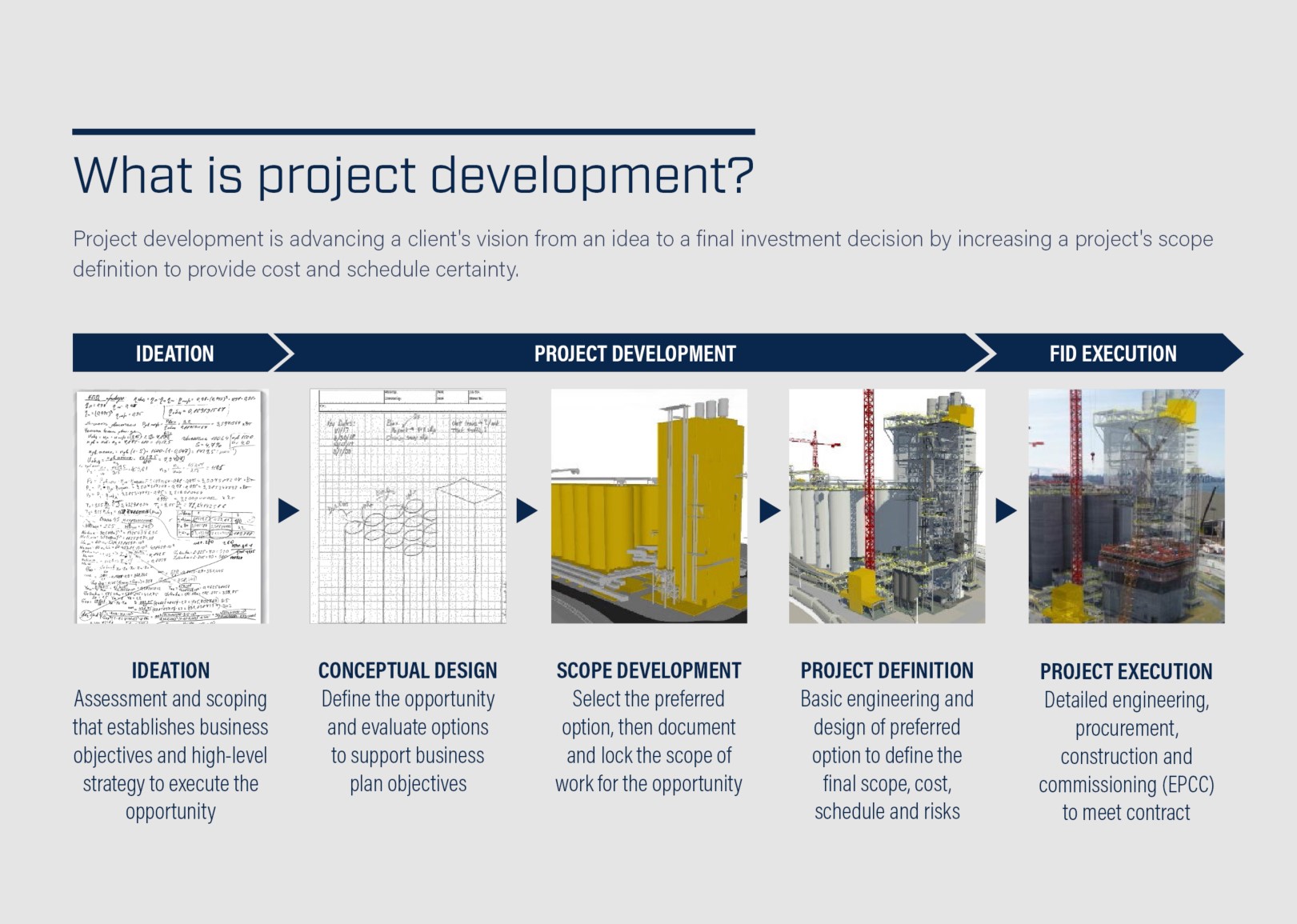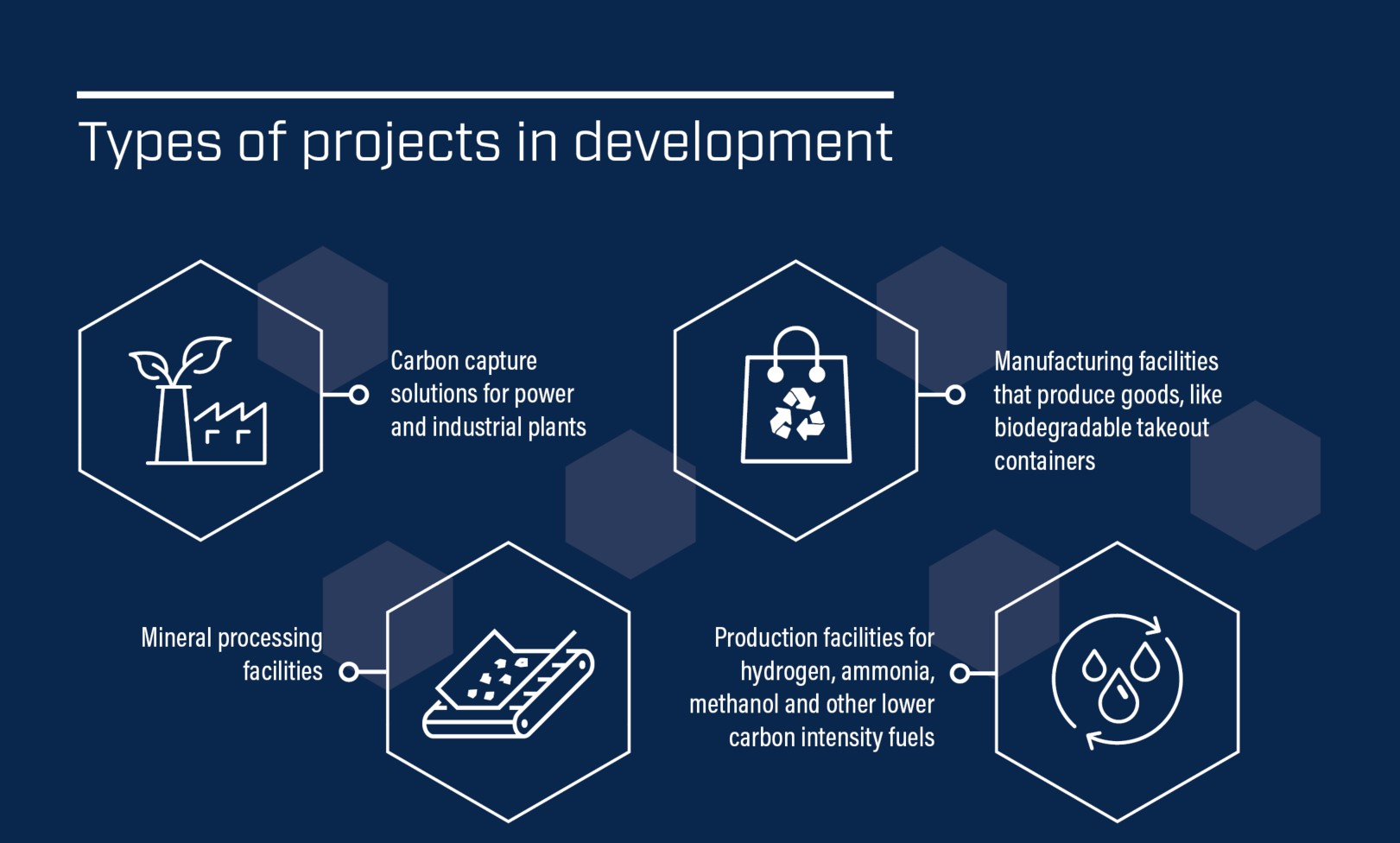There’s plenty of lore about big ideas that originate as something quite simple. A note on the back of a napkin kick-starts a new creative endeavor or business venture.
So, what happens next? How do you get those ideas off the napkin — or the pages of a notebook, the whiteboard of an office, the notes app in a phone — and turn them into something that has a legitimate shot at becoming real?
In the world of energy and industrial capital projects, it’s a phase called project development. Increasingly, clients are turning to Kiewit during this phase to help advance their vision from initial idea to something worthy of a final investment decision (FID). The objective is to increase a project’s scope definition to provide cost and schedule certainty and a high probability that it meets the required business plan objectives.
“As we’ve continued to grow our engineering business, clients are gravitating to Kiewit for project development support,” said Kiewit Engineering Group Inc. President Dan Lumma, noting that the company’s revenues in project development have increased more than tenfold since 2021.
Clients range from some of the largest oil, gas and chemical organizations in the world, to new startup companies. Many of them are looking to develop solutions to further energy transition and sustainability efforts to build a greener economy. Production facilities for hydrogen, ammonia, methanol and other lower carbon intensity fuels; carbon capture solutions for power and industrial plants; mineral processing facilities; and manufacturing facilities that produce goods — like compostable takeout containers — from more sustainably sourced materials are among the many projects Kiewit is supporting.
Clients vary in terms of their level of understanding of the project development processes.
“Some of our clients know exactly what they want out of the process and have higher expectations,” said David Newton, director of Kiewit’s oil, gas and chemical engineering operations. “But we also work with investors who come to us, and engineering is not what they do. They’re trying to develop investment packages and need our help to determine if an idea is cost effective and if it matches their business model to proceed forward.”
Feasibility studies, front end loading (FEL) and front-end engineering and design (FEED) are common project development models that Kiewit completes for these clients. A feasibility study is a high-level suitability investigation for a client’s project concept used in the early stages of project development. FEL, as defined by Association for the Advancement of Cost Engineering (AACE), is a phased development process with client approval gates occurring through phases. FEED often follows a feasibility study, or pre-FEED, and includes basic engineering and design to advance project definition.
The models have phases that start with conceptual design, which leads to further scope development before completing a final project definition for FID. The project definition is built on three major outcomes: engineering deliverables, an engineering, procurement and construction (EPC) schedule, and price.
The overall process is very iterative.

“It’s not a smooth curve,” said Lumma. “You do things and then undo them. You go down one road and then another. It’s a very iterative process to figure things out.”
This allows Kiewit and clients to think creatively through many possible paths to meet the business objective. What would happen if we selected a different site? Laid the plant out in a different configuration? Used different technology or equipment?
Stage gates throughout the project development timeline provide opportunities to evaluate deliverables in multiple phases. These stage gates are a time to course-correct and make decisions to move forward down a particular path. Sometimes, it leads to a decision to take an off-ramp and not proceed with the project, if it becomes clear business objectives can’t be realistically met.
A key differentiator between Kiewit and other firms performing project development work is the company’s experience self-performing construction. The historical data on costs and schedule are a huge advantage for project development.
“We’re often selling to our clients that we engineer with construction in mind, because in North America, one of the largest cost drivers is the construction costs due to labor,” said Newton.
While Kiewit’s engineering teams initiate its project development endeavors, construction professionals are brought in early to provide input and perspective for field execution.
“We get construction operations involved as soon as possible,” said Brian Kearns, vice president of project development for Kiewit’s industrial and water engineering team. “It starts with high-level, cursory involvement, but construction operations gets much more involved as we get to FEL 2 and beyond.”
“Once we get to a pre-FEED or FEL 2, we’ll get construction folks involved for discussion on things like concept for modularization, traffic and logistics for a workers’ camp, and optimizing crane access,” said Newton. “Then as we get closer to FEL 3 or full FEED, we get into more detail to confirm our construction execution plan and schedule.”
As clients look beyond the project development phase, past FID and into project execution, construction experience as a differentiator becomes even more apparent. For clients, the opportunity to convert project development contracts to EPC contracts when an FID is approved allows for a smooth transition from into project execution.

“Traditionally there’s a risk to a client that there are going to be changes down the road due to constructability efforts that drive back to ‘the engineer didn’t know,’” said Kearns. “That risk is reduced with a contract conversion, and it can increase the speed to market. We also bring to the table a consistency of being involved from beginning to end that carries a lot of weight.”
Phil Welsh, executive vice president of Kiewit’s power engineering group, oversees a team focused on project development of carbon capture solutions. The consortium of Kiewit subsidiary TIC – The Industrial Company and Mitsubishi Heavy Industries America engineered, procured and constructed the Petra Nova Carbon Capture Project, the first in the United States. Though Petra Nova wasn’t a project development effort for the Kiewit organization, the EPC project execution experience carries a lot of weight with Welsh’s clients.
“When we’re designing projects for companies with these first-of-their-kind technologies, they want the comfort of knowing the people building their project are experienced and build large projects all the time,” said Welsh.
Kiewit’s leaders are focused on continuous improvement, and employee development is an important focus. They’re committed to ensuring employees continue to gain the experience and expertise they need to be successful in a project development environment and understand how those experiences benefit their personal careers. Employees can pursue advanced degrees and participate in industry events, organizations and internal committees. Kiewit’s Chief Engineers Council is instrumental in leading these employee engagement efforts.
One of the major selling points for employees comes back to one of the same differentiators for clients: Kiewit’s ability to not just engineer these projects — but also build them.
“People can come to Kiewit and be part of projects from the earliest development phases and see them move all the way to project execution and support it getting built in the field,” said Lumma.
Kiewit Engineering Technical Summit drives conversations on fresh ideas and innovative thinking
Kiewit’s Chief Engineers Council sponsors the annual Kiewit Engineering Technical Summit. Kiewit engineers present project case studies, innovations in technology, and examples of Kiewit’s holistic, integrated approach to projects that leverage the full complement of the company’s engineering capabilities.
Each day of the three-day event features an external keynote presentation highlighting the changes and trends in Kiewit’s markets.
For Kiewit engineers and external attendees, the summit provides an opportunity to share innovations, consider how Kiewit’s markets will change in the next 5, 10 or 20 years and discuss how Kiewit can prepare to meet the needs of a rapidly evolving marketplace.
Attendees can earn professional development hours. Additionally, it provides presenters with opportunities to continue to develop their presentation skills and demonstrate their expertise.


